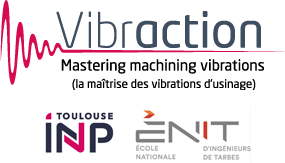Example of proposed approach:
General principles: Use the 4 key parameters:
- Stiffnesses, as it controls static flexion and vibrations (if the stiffness is too low, chatter is unavoidable).
- Natural frequencies, because only the optimal spindle speeds make it possible to exploit the potential of the machining system (resonances must be avoided).
- Damping, because it is a factor aggravating the vibrations (if the damping is too weak, the vibrations are almost inevitable).
- Radial cutting force, because reducing radial force means reducing flexion and vibration.
Practical approach (3 days):
- Analysis of the machine-tool-part-part_holder system:
- Machine analysis: stiffnesses, natural modes (ping test), damping, accelerations/jerk/axis vibrations during G0 G1 G2 G3, spindle vibrations (over the entire speed range).
- Ping test of all major tools (heavily used tools, long and/or heavy tools, problematic tools).
- Process analysis: in-depth analysis of surface finish, analysis of machining vibrations, estimation or measurement of the radial component of the cutting force.
=> Identify the weak elements (spindle speed to avoid, insufficient stiffness or instability of a machine axis, damping of a workpiece holder, etc.), and determine the best spindle speeds for all major tools (also taking into account machine and tool limits).
=> Identify the phenomena to be combated (the machining signal clearly indicates runout, unbalance, intermittent cutting, resonances, more or less chaotic chatter).
=> Detect all factors that can be more productive (anytime machining is far from chatter)
=> Adapt the process to eliminate the problems detected (via speed adjustments or reductions in Ap Ae fz, depending on the type of problem), but also to increase wherever possible (↗Ap, ↗Ae, ↗fz), i.e. until the vibration signal detects the limits of the tool.
- Optimization of future process:
- Strengthen the weak parameters previously detected.
- Machine: recommendations of servo control adjustments or axis repair (with precise objectives).
- Workpiece holder: stiffening of part-holder, clamping systems, vacuum holders, etc.
- Tools:
- Stiffness : increase the body diameters, or shorten the lengths, or change the shrink fit, or change tool-holder.
- Resonance (i.e., natural frequency and damping) : optimal choice of rotational speed, damping improvement, optimal variable pitch, structural modification to change a natural frequency that is too annoying.
- Radial force : choice . reduction of radial effort via a choice of optimized cutting angles, helix angle, coatings, edge finish, but also by adjusting Ae.
- Tool by tool: determine the optimal parameters (N from ping test, Ap from raw calculation and from machining test, by seeking the limit of chatter minus margin of 20%, optimal Ae to reduce vibrations, fz to either reduce vibrations or at the limit of chatter -20% ), and reduce the number of operations as accurately as possible by calculating the actual chip thicknesses, taking into account the flexion, at each step (possibly using software to optimize the feed rate all along the path).
- Monitoring (to protect machine axis, monitor damage over time and anticipate vibrations of major tools, and continue to detect productivity sources) :
- Conventionally monitor the machine with no load (specific program to monitor spindle bearings, unbalances, etc.)
- Possibly monitor in more detail (specific programs to monitor motor currents, backlash, axis oscillations, etc.)
- Monitor during machining (to detect changes, or possible improvements, etc.): maximum acceleration threshold, frequency band threshold (spindle and axis protection), possibly by tool (detection of too violent interrupting cutting or chatter, for example)



